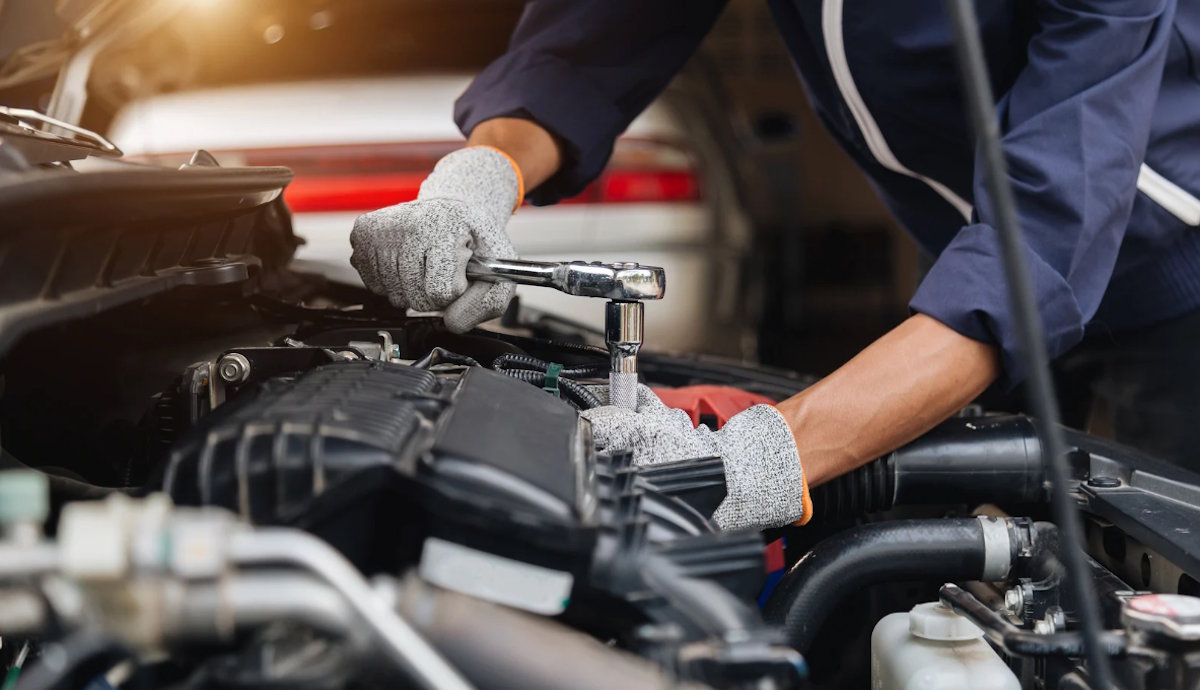
There are few sights in the daily life of a car owner that trigger such an immediate, sinking feeling of dread as backing out of a parking space and seeing a fresh, glistening puddle on the concrete where your vehicle just stood. That dark, wet stain is an accusation. It is a physical manifestation of a mechanical failure, a breach in the sealed systems that keep your machine alive. In the hustle of modern life, the temptation to ignore this warning is powerful. We rationalize it as condensation, or perhaps a spill from another car, or we promise ourselves that we will simply top up the reservoir and deal with it later.
This rationalization is a dangerous financial gamble. A modern vehicle is a complex network of closed-loop hydraulic and chemical systems. Under normal operation, a car should consume and emit absolutely nothing but fuel and exhaust. Any fluid on the outside of the engine is a sign that a gasket, seal, or hose has failed under the immense pressure and heat of the engine bay. Ignoring a leak is akin to ignoring a bleeding wound; it does not heal itself, and the loss of vital fluids will inevitably lead to the catastrophic failure of the engine, transmission, or braking system. Understanding the color, texture, and location of these leaks is the first step in deciphering your car’s desperate cry for help.
The Black Omen: Engine Oil and the Death of Seals
The most common, and often the most insidious, fluid to find on your garage floor is engine oil. Fresh engine oil appears as a golden or amber liquid, but by the time it has circulated through a hot engine and picked up carbon deposits, it usually appears dark brown or jet black with a slick, greasy texture. Finding a few drops of oil might seem like a minor annoyance, a sign of an older car just showing its age, but in the UAE’s extreme climate, it signals a specific type of material failure that affects every vehicle eventually.
Your engine is composed of metal parts that expand and contract with heat, bolted together with rubber or silicone gaskets sandwiched in between to keep the oil inside. In the fifty-degree summers of the Gulf, these rubber gaskets are subjected to a brutal cycle of baking heat and cooling. Over time, the volatile chemicals in the rubber evaporate, causing the gaskets to become hard, brittle, and plastic-like. They lose their elasticity and their ability to seal the gap between the metal parts. A leak from the valve cover gasket at the top of the engine might only cause a burning smell as oil drips onto the exhaust, but a leak from the rear main seal at the bottom of the engine is a major structural failure that can drain the oil sump rapidly, leading to oil starvation and a seized engine. The “top-up” strategy is particularly dangerous here, as it masks the rate of loss while the leak inevitably widens, eventually leading to a sudden, catastrophic loss of pressure while driving.
The Sweet Smell of Danger: Coolant and the Pressure Cooker
If the puddle on your driveway is a bright, vibrant color—typically neon green, fluorescent orange, or pink—and has a watery consistency with a sweet, syrupy smell, you are looking at engine coolant. This is arguably the most urgent leak to address because the cooling system operates under extreme pressure. Unlike an oil leak, which might drip slowly for months, a coolant leak is often the precursor to a violent explosion of steam and an immediate breakdown.
The cooling system relies on maintaining internal pressure to raise the boiling point of the fluid, preventing it from turning into steam inside the engine block. A visible leak means the system has been breached and can no longer hold this pressure. This breach is often caused by the failure of plastic components, such as the radiator end-tanks or the thermostat housing, which become brittle and crack after years of exposure to hot coolant. A small drip today indicates a hairline fracture that is struggling to contain the hot, pressurized fluid. At any moment, especially during a long highway drive or in heavy traffic, that fracture can burst open, dumping the entire contents of the cooling system onto the road in seconds. Without coolant, the engine temperature will skyrocket instantly, warping the aluminum cylinder head and destroying the engine before you can even safely pull over. A coolant leak is never a “monitor and wait” situation; it is an immediate emergency.
The Red Alert: Transmission Fluid and the Hydraulic Heart
A puddle of fluid that appears deep red or reddish-brown suggests a leak from the automatic transmission or, in some hydraulic setups, the power steering system. Transmission fluid serves a fundamentally different purpose than engine oil; it is not just a lubricant, but a hydraulic fluid that acts as the muscle of the car, transferring power and actuating gear shifts. Because the transmission is a closed, pressurized hydraulic loop, even a small loss of fluid volume can have devastating effects on drivability and the longevity of the unit.

Modern transmissions are incredibly sensitive to fluid levels. A loss of just half a liter can cause the hydraulic pressure to drop, leading to delayed engagement, slipping gears, or harsh, jerking shifts. As the fluid leaks out, the remaining fluid overheats rapidly, burning the delicate clutch packs inside the transmission. Unlike an engine, which has a dipstick and a wide tolerance for oil levels, many modern transmissions are sealed units without dipsticks, making it impossible for the owner to check the level or top it up accurately. By the time you see red fluid on the ground, the internal components of the transmission may already be suffering from heat damage and slippage. Ignoring a red puddle is the fastest way to turn a fifty-dirham seal replacement into a twenty-thousand-dirham transmission rebuild.
The Invisible Threat: Brake Fluid and the Paint Peeler
Perhaps the most terrifying leak to discover is one that is clear or slightly yellowish, with the consistency of dry white wine. This is brake fluid, and its presence on the ground indicates a critical breach in the safety system that stops your car. Brake fluid is extremely corrosive; if you touch it to your car’s paintwork, it will strip the paint down to the metal within minutes. If it is leaking onto your driveway, it means a brake line, a caliper seal, or the master cylinder has failed.
The danger of a brake fluid leak cannot be overstated. The braking system relies on hydraulic pressure to clamp the brake pads against the rotors. A leak introduces air into the system. Since air is compressible and fluid is not, when you press the brake pedal, the force is wasted compressing the air bubble rather than stopping the car. This results in a spongy pedal that goes to the floor or, in a worst-case scenario, total brake failure. Furthermore, because brake fluid absorbs moisture from the atmosphere, a leak acts as a two-way street, allowing humid air to enter the system and rust the components from the inside out. A car with a brake fluid leak is unsafe to drive at any speed and requires immediate towing to a specialist for repair.
The False Alarm: Water and the Air Conditioning
Not every puddle is a portent of doom. In the humid climate of the UAE, it is extremely common to find a pool of clear, odorless, tasteless water under the passenger side of the vehicle after a drive. This is the one leak that is actually a sign of a healthy system. It is condensation from the air conditioning evaporator.
As your AC system pulls humidity out of the cabin air to cool it, that moisture condenses into liquid water and is drained out of the vehicle through a rubber tube. On a humid summer day, a properly functioning car can produce a significant amount of water, creating a large puddle in a short time. Distinguishing this from other fluids is simple; if it looks like water and dries completely without leaving a greasy stain or a color, it is condensation. However, if the water is pooling on the passenger floor mat inside the car instead of on the ground outside, it indicates that the drain tube is clogged, which requires service to prevent mold growth and electrical damage to the dashboard components.
Conclusion: The High Cost of Procrastination
The psychology of the “top-up” is a trap. Many drivers believe that as long as they keep adding fluid to the reservoir, the car is safe to drive. This logic is flawed because it addresses the symptom while ignoring the disease. Adding oil does not fix the hardening gasket that will eventually blow out completely. Adding coolant does not repair the cracking radiator that is waiting to burst. Adding brake fluid does not remove the deadly air bubbles from the lines.
Fluid leaks are progressive failures. They start small, but the heat, pressure, and vibration of driving act as a wedge, inevitably driving the breach wider. What starts as a seep becomes a drip, and what starts as a drip becomes a torrent. The cost of fixing a leak is almost always a fraction of the cost of repairing the damage caused by the leak’s eventual failure. Replacing a valve cover gasket is a standard maintenance task; replacing an engine seized from oil starvation is a financial catastrophe. Replacing a radiator hose is a minor repair; replacing a warped cylinder head from overheating is a major overhaul. By treating every spot on the driveway as a mandatory diagnostic event rather than a nuisance, you protect not just the mechanical integrity of your vehicle, but its value and your own safety on the road. The puddle is speaking to you; the only question is whether you are willing to listen before the silence of a broken engine takes over.
